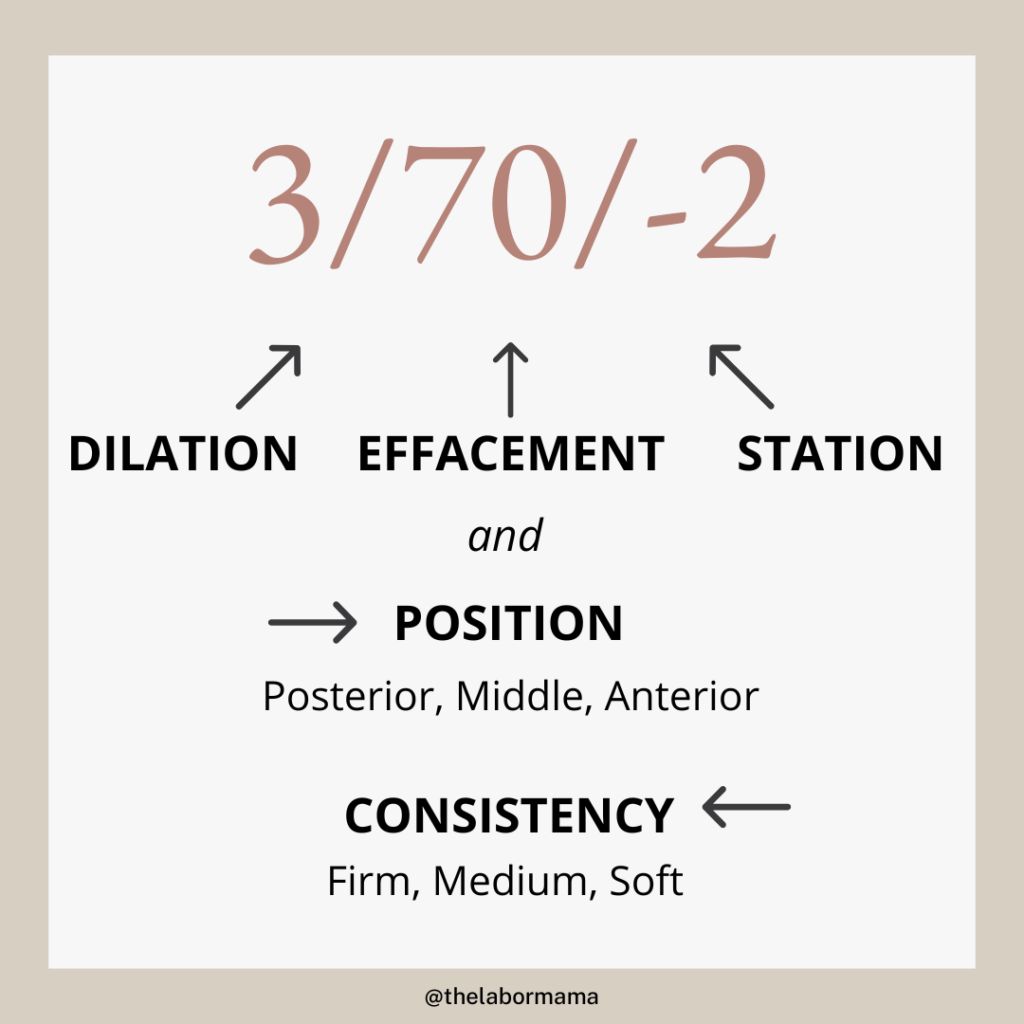Want to know one of my favorite topics in labor and birth? The cervix! I know, it’s probably a little weird. But the cervix can be such a storyteller. For many, changes in cervical dilation & effacement start happening in the weeks leading up to birth. And we are all constantly asking ourselves the question, “Should I get a cervical exam or not” in those final weeks of pregnancy. Equally so, most of us don’t FULLY know what those numbers all mean. Though most of us know the most about dilation, there are actually 4 ways we can categorize cervical changes. So, I want to talk about all of it, plus more, here for you!

But before we dive into the types of contractions – Who is The Labor Mama and Why Am I Here?
Hey friend! I’m Lo – also known around here and social media as The Labor Mama. I’ve spent my nursing career in labor, delivery, and postpartum, have birthed 4 of my own babies, have labored thousands of mamas at the bedside, have taught thousands of students online, and have even delivered a few speedy little babies with my bare hands (oops).
Here at TLM, I offer online classes about birth, postpartum, newborn care, and breastfeeding to empower you the way everyone should be. The education + support I offer gives you experience, evidence, and empathy; you’re getting all of my years of “clinical” RN knowledge, honestly combined with my real experiences as a mama, nurse, and CLC. These are not your average hospital classes (those won’t do it, I promise), and honestly, birth, postpartum, and breastfeeding don’t follow a textbook or protocol anyway. You need to know so much more than that!
If you want to connect with me further, head to Instagram. There are hundreds of thousands of us over there learning together daily.
A note: This post may include affiliate links. This means if you make a purchase after clicking a link, I will earn a small commission (thank you)! Rest assured, this comes at no additional cost to you. You can read TLM’s full disclosure here.
What is the cervix?
The cervix is the lower portion of the uterus. Sometimes it is called the neck of the uterus. The cervix exits into the vagina, also called the birth canal, which is sandwiched between the bladder in front and the rectum behind.
The cervix is both muscle and connective tissue and it plays an integral role in both pregnancy and delivery. During pregnancy, you need the cervix to stay thick, long, and firm. As you creep closer to your due date, the cervix will start to thin, open, and soften. These processes are cervical dilation and effacement! When you combine effacement and dilation with regular, strong, rhythmic contractions of the uterus, the baby can then descend down and through the birth canal.
What is a cervical exam?
A cervical exam is also called a sterile vaginal exam (SVE). During an SVE, a trained provider with gently insert 2 gloved fingers through the vagina and to the cervix. Using their fingers, they will assess what the cervix feels like and where it is at. Typically, you will be asked to lie on your back or your side for an SVE, though it can be done on hands and knees.
Should you say yes to a cervical check?
Some find SVEs really uncomfortable. For others, they are no big deal. Everyone will be different in how they experience an SVE. They can also feel more uncomfortable earlier on in the process. Overall, make sure you let your provider know how you are doing and feeling both before and during the process. You can pop over to this Instagram post if you want a few more considerations or tips on making these exams a little bit easier.
A note: Cervical exams are a choice! You do not need to have them done prenatally if you do not want to know! They are also not the same thing as a membrane sweep. If you have a cervical exam prenatally, be really clear with your provider about what you have agreed to and what they are allowed to do!
Read more: What is a Membrane Sweep & Should You Try One?
So, what exactly is cervical dilation & effacement?
When someone checks your cervix, they are examining 5 different things: dilation, effacement, position, and consistency of the cervix and the station of the baby in the pelvis. Each of these measures can be given a value or score – and these numbers help your care team know how you are progressing. The values can also be a tool to help make decisions during induction or augmentation (I’ll chat about that too).
Some of you will receive your first cervical exams prenatally. Many providers begin offering them at the 37-week prenatal appointment. You can also choose not have those done, so your first exam may be during the labor process. Here is a better description of each of the 5 things being checked on.
Dilation
Cervical dilation gets all the glory! Dilation refers to the opening of the cervix. This is measured in centimeters, with 10cm being a fully open and dilated cervix. Your cervix should stay closed through your pregnancy, but it’s okay if it starts to open in the last few weeks leading up to labor.
Effacement
I actually think effacement is such an important measure, but we give it a little less credit. This measure is about the thickness of your cervix. Similar to dilation, your cervix should stay nice and thick through your pregnancy, but it can start to thin out in the last weeks as you get closer to labor. Effacement is measured in percentages, moving from “0% effaced to 100% effaced.”
Position
For most, the cervix is pretty posterior throughout their pregnancy. This means that it sits more towards the back of your body. As you get closer to labor, and definitely during labor, the cervix “rolls” forward to more of an anterior position (which usually makes those cervical exams a little less uncomfortable too).
Consistency
Cervical consistency, or “ripening,” is related to how soft your cervix is. Through your pregnancy, your cervix should be nice and firm (as well as thick and closed like I mentioned). Towards the end of the pregnancy, and definitely in labor, the cervix will “ripen” or soften, which makes it far more likely to open and thin out.
Station
Station is the third number in a cervical exam, typically a number between -4 to +4. It is not about the cervix. It is about where your baby is in the pelvis. The negative numbers mean your baby is still higher up in your pelvis. The positive numbers mean the baby is moving down and towards crowning (usually about +3 station). If someone notes that your baby is ballotable, that indicates that they are not engaged at all; this is comparable to a -4 or -5 station.
When the baby’s presenting part (usually the head) enters the pelvis, it’s usually considered to be engaged at about a -3 station. When the baby’s head reaches the midline points, called the ischial spines, that head is considered “fully engaged” and at 0 station.

Is it better to dilate or efface first?
My answer is neither! Though dilation is what many people talk about the most, all 5 of these things really matter. Labor progress is not only about how open the cervix is. If your baby moves down, the cervix gets thinner or rolls to the front of your body – these are all signs of progress even if the dilation doesn’t change!
What is a Bishop Score?
Your care team can actually assess the “ripeness” of your cervix and give it a number of favorability (how ready it is for labor). This is done with something called a Bishop Score. When calculating a Bishop Score, your care team gives “points” for cervical dilation and effacement, consistency, position, and the fetal station.
What is a Bishop Score for?
Most often, the Bishop Score is used before starting an induction or starting Pitocin. The overall score can be as low as 0 and as high as 13. A score of 8 or > is considered to be favorable for vaginal delivery. This means the cervix is ripe and more likely to respond well to the labor process. A Bishop Score of 6 or < is not favorable – it’s not ripe! Ideally, a cervix is allowed to “ripen” before the labor process begins or before beginning an induction medication like Pitocin.

Are you geeking out on all of this AND know you want and need so much more education like it? I’ve created Your Body, Your Birth for you. If you want to navigate your birth with confidence, you MUST engage in some type of education. It will absolutely change your story (and your outcomes). Once you join, you’ll have instant access to 13 modules that walk through your pregnancy, birth, and postpartum, giving you access to the information you need to have a much better birth experience!
The takeaway on cervical dilation & effacement
Yes, the cervix is such a big piece of the labor and delivery process! And it is important that you understand what the cervical exam is, that you have the right to decline one, and what the results of the SVE tell you and your team. I also think it is so important that you know that there are a lot of different ways of determining how labor is progressing. Dilation and effacement are not the only things that matter and they are not the only sign that things are going “well.” Trust your new knowledge and trust the process, even if it moves slowly or doesn’t seem to be exactly like the textbook says!
Did you have any cervical exams? Are you glad you did or would do the same again? Your story can def help the rest of us; please share in the comments. xx – Lo
More resources (and freebies!) for you to take a peek at:
- Comprehensive Birth Plan and Birth Priorities templates
- A complete Third Trimester Checklist
- The RN + mama of 4 Ultimate Packing List
- The Labor Mama online classes for every family





